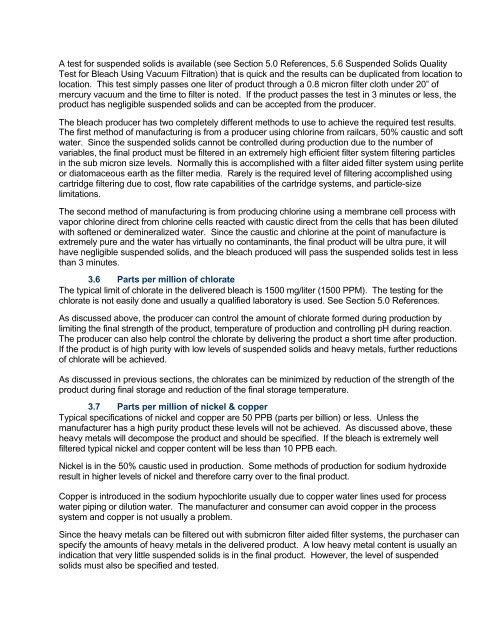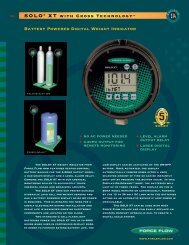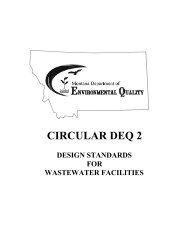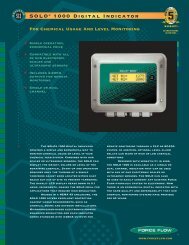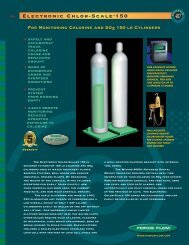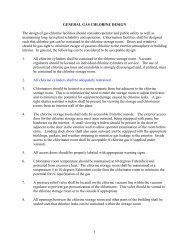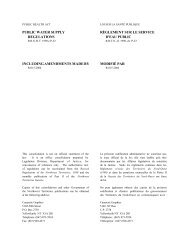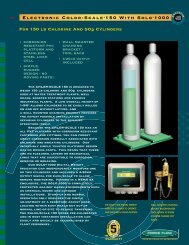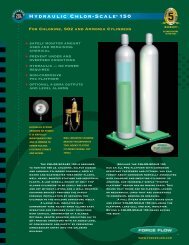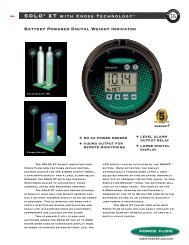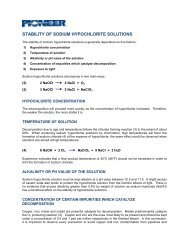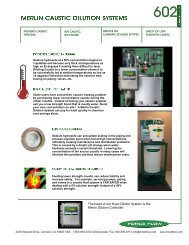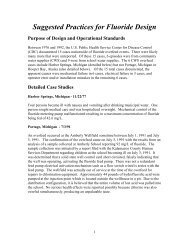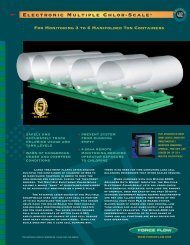Sodium Hypochlorite Handbook - Force Flow
Sodium Hypochlorite Handbook - Force Flow
Sodium Hypochlorite Handbook - Force Flow
You also want an ePaper? Increase the reach of your titles
YUMPU automatically turns print PDFs into web optimized ePapers that Google loves.
A test for suspended solids is available (see Section 5.0 References, 5.6 Suspended Solids QualityTest for Bleach Using Vacuum Filtration) that is quick and the results can be duplicated from location tolocation. This test simply passes one liter of product through a 0.8 micron filter cloth under 20” ofmercury vacuum and the time to filter is noted. If the product passes the test in 3 minutes or less, theproduct has negligible suspended solids and can be accepted from the producer.The bleach producer has two completely different methods to use to achieve the required test results.The first method of manufacturing is from a producer using chlorine from railcars, 50% caustic and softwater. Since the suspended solids cannot be controlled during production due to the number ofvariables, the final product must be filtered in an extremely high efficient filter system filtering particlesin the sub micron size levels. Normally this is accomplished with a filter aided filter system using perliteor diatomaceous earth as the filter media. Rarely is the required level of filtering accomplished usingcartridge filtering due to cost, flow rate capabilities of the cartridge systems, and particle-sizelimitations.The second method of manufacturing is from producing chlorine using a membrane cell process withvapor chlorine direct from chlorine cells reacted with caustic direct from the cells that has been dilutedwith softened or demineralized water. Since the caustic and chlorine at the point of manufacture isextremely pure and the water has virtually no contaminants, the final product will be ultra pure, it willhave negligible suspended solids, and the bleach produced will pass the suspended solids test in lessthan 3 minutes.3.6 Parts per million of chlorateThe typical limit of chlorate in the delivered bleach is 1500 mg/liter (1500 PPM). The testing for thechlorate is not easily done and usually a qualified laboratory is used. See Section 5.0 References.As discussed above, the producer can control the amount of chlorate formed during production bylimiting the final strength of the product, temperature of production and controlling pH during reaction.The producer can also help control the chlorate by delivering the product a short time after production.If the product is of high purity with low levels of suspended solids and heavy metals, further reductionsof chlorate will be achieved.As discussed in previous sections, the chlorates can be minimized by reduction of the strength of theproduct during final storage and reduction of the final storage temperature.3.7 Parts per million of nickel & copperTypical specifications of nickel and copper are 50 PPB (parts per billion) or less. Unless themanufacturer has a high purity product these levels will not be achieved. As discussed above, theseheavy metals will decompose the product and should be specified. If the bleach is extremely wellfiltered typical nickel and copper content will be less than 10 PPB each.Nickel is in the 50% caustic used in production. Some methods of production for sodium hydroxideresult in higher levels of nickel and therefore carry over to the final product.Copper is introduced in the sodium hypochlorite usually due to copper water lines used for processwater piping or dilution water. The manufacturer and consumer can avoid copper in the processsystem and copper is not usually a problem.Since the heavy metals can be filtered out with submicron filter aided filter systems, the purchaser canspecify the amounts of heavy metals in the delivered product. A low heavy metal content is usually anindication that very little suspended solids is in the final product. However, the level of suspendedsolids must also be specified and tested.


